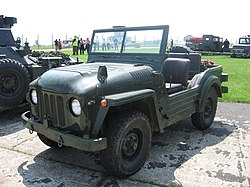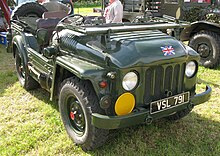Austin Champ
| Austin | |
|---|---|
|
Austin Champ
|
|
| FV1801 Truck ¼ ton 4 × 4 (UK) -Austin Champ- | |
| Production period: | 1951-1956 |
| Class : | Off-road vehicle |
| Body versions : | Kübelwagen , pickup |
| Engines: |
Petrol engine : 2.8 liters (58 kW) |
| Length: | 3660 mm |
| Width: | 1650 mm |
| Height: | 1870 mm |
| Wheelbase : | 2032 mm |
| Empty weight : | 1660 kg |
| successor | Austin Gipsy |
The Austin Champ is the civil version of a British military off-road vehicle from the 1950s and 1960s. It was manufactured by the Austin Motor Company . The military version is officially called Truck 1/4 Ton 4x4 CT .
history
As early as the late 1940s, during the Second World War , the British Army was drawing up specifications for a light truck that was based on the American Willys MB jeep. They wanted a vehicle made in Great Britain so as not to have to rely on American jeeps and to save valuable foreign currency .
The "Car 4x4 5 cwt FV1800-Series" project began in 1945. The automobile manufacturer Nuffield Organization built three prototypes that became known as the " Nuffield Gutty " or "Morris Gutty". The subsequent tests uncovered serious design flaws that were to be rectified by a working group. It is noteworthy that the suspension system was developed by Sir Alec Issigonis , who later became known for the development of the Mini .
The Wolseley Motor Company produced prototypes of this improved vehicle , which were given the name "Wolseley Mudlark" (English for "dirt finch").
Finally, the Austin Motor Company received the order to manufacture 15,000 vehicles and the first vehicle left production on September 1, 1951. The vehicle was formally designated "Truck 1/4 Ton 4x4 CT Austin Mk.1", where CT stands for CombaT .
In order to enable some commercial success, Austin received permission to produce a simplified version for the civilian market, which was then sold under the name "Champ" and mostly exported.
Even when the Champ was put into service, it became clear that it was too expensive and too complicated despite its outstanding off-road capabilities. Therefore, the contract with Austin was terminated prematurely. The first Land Rovers were used by the Army even before the Champ. The Land Rover was only about half the price of a Champ, but could do almost the same. Ultimately, he completely replaced the champ.
The champ was used by the British Army in the United Kingdom , Africa, Germany and Cyprus, and was used in the Suez Crisis and the Korean War .
The champ has never been as popular and famous as the Land Rover. The last military champs were decommissioned in 1967.
Except for the British Army, the Champ was only used by the Royal Marines , who had 30 pieces, and the Australian Army , which bought 400 pieces.
description
The Champ has a four-seater, open body shell made of welded pressed steel parts, which is partially self-supporting. The windshield can be folded forward onto the bonnet. A shovel is attached to the outer left of the body and an ax to the outer right. The spare wheel and the spare canister are located on the outside of the rear of the vehicle. The vehicle has a 91 liter fuel tank, which enables a range of 700 km (range 350 km). In order to adapt the Champ to special tasks, various mounting and attachment kits have been developed.
While the early vehicles were still powered by a Rolls-Royce B40 four-cylinder gasoline engine with a displacement of 2,838 cm², later vehicles received an almost identical engine that Austin itself produced under license.
The transmission has five synchronized gears. The power transmission, which is quite unconventional for an off-road vehicle, is carried out by means of a cardan shaft to the rear differential , in which a small gear for reverse gear is also integrated. This construction means that, at least in theory, it is also possible to drive backwards in all 5 gears. A long cardan shaft leads from the rear differential to the front differential. There, the front axle can be switched on by means of a simple dog clutch to enable all-wheel drive . The use of a conventional separate transfer case was not possible because the center of the X-shaped vehicle frame is located exactly at the point where the transfer case would have been installed in a classic ladder frame . All four drive shafts are equipped with constant velocity joints and the entire drive train is sealed watertight.
The suspension system is based on longitudinally installed torsion bars that generate the main spring effect. The vehicle has independent wheel suspensions with double wishbones - wheel suspensions on all four wheels. Each wheel suspension is equipped with rubber buffers and hydraulic shock absorbers . Overall, the suspension system enables exceptionally good off-road handling.
The motor and all electrical components are sealed watertight. When the snorkel , normally on the right fender, is upright, the vehicle reaches the extraordinary fording depth of 2 meters.
Web links
literature
Ware, Pat: The Quarter ton Utility in British Military Service 1941-1958: Ford & Willys Jeep, Austin Champ, Land Rover series 1 , Verlag Warehouse (1996), ISBN 0952556324

